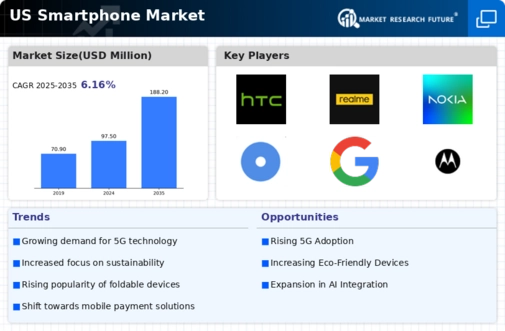Top Industry Leaders in the US Smartphone Market

Competitive Landscape of the US Smartphones Market:
The US smartphone market, epitomizes the fiercely competitive landscape of the global technology industry. At its heart lies a constant struggle for market share between a select group of established giants and a wave of innovative newcomers brimming with fresh ideas and disruptive approaches.
Key Players:
- Infineon Technologies
- Texas Instruments Incorporated
- Toshiba Corporation
- Panasonic Corporation
- NexGen Power Systems
- Efficient Power Conversion Corporation
- STMICROELECTRONICS
- Navitas Semiconductor Corporation
Strategies Adopted by Leaders:
- Brand Loyalty and Premium Positioning: Apple cultivates a strong brand image associated with quality, innovation, and user experience. Samsung leverages its brand recognition and diverse product portfolio to cater to different price points and user preferences.
- Advanced Features and Technological Leadership: Both companies invest heavily in R&D, offering cutting-edge features like high-resolution displays, powerful processors, sophisticated camera systems, and advanced security features.
- Strong Distribution Networks and Carrier Partnerships: Strategic partnerships with major carriers and retailers ensure wide product availability and attractive bundled deals, influencing customer purchasing decisions.
- Focus on User Experience and Ecosystem Integration: Both companies provide intuitive user interfaces, seamless integration with their respective ecosystems (Apple's iOS and Samsung's Android with One UI), and a growing range of connected services.
- Emphasis on After-Sales Support and Customer Service: Robust customer service networks and long-term software updates build trust and loyalty, encouraging repeat business.
Factors for Market Share Analysis:
- Brand Recognition and Reputation: Strong brand image, positive customer reviews, and association with innovation significantly impact purchase decisions.
- Product Portfolio and Feature Differentiation: Offering a diverse range of devices with unique features at different price points caters to various user segments and budget constraints.
- Operating System (OS) Preference: The longstanding battle between iOS and Android shapes user choices, with iOS known for its user-friendly interface and security, while Android offers greater customization and affordability across brands.
- Marketing and Advertising Strategies: Effective marketing campaigns that highlight product features, target specific demographics, and leverage influencer marketing can significantly impact brand perception and sales.
- Carrier Partnerships and Promotions: Exclusive carrier deals, bundled services, and device subsidies significantly influence user choices, especially for budget-conscious consumers.
New and Emerging Players Seek Opportunities:
- Niche Market Focus: Some target specific demographic groups with budget-friendly devices, innovative features like foldable phones, or cater to specific needs like ruggedized devices for outdoor enthusiasts.
- Online Sales and Direct-to-Consumer Models: Utilizing online platforms and bypassing traditional carrier channels allows them to offer competitive pricing and cater to a broader customer base.
- Focus on Innovation and Disruptive Technologies: Smaller players may be quicker to adopt innovative features like under-display cameras, faster charging technologies, or unique camera configurations.
- Emphasis on User Privacy and Security: With growing concerns about data privacy, companies that prioritize secure operating systems and transparent data practices could attract privacy-conscious users.
- Strategic Partnerships with Niche Carriers and Retailers: Collaboration with smaller carriers and online retailers can provide these players with a foothold in a saturated market.
Latest Company Updates:
Apple:
- February 22, 2024: Announced the launch of the iPhone 15 series with a rumored under-display fingerprint sensor and improved cameras.
- January 19, 2024: Unveiled a new augmented reality headset at its developer conference.
Samsung:
- February 15, 2024: Launched the Galaxy Z Fold 5 with enhanced durability and a larger foldable display.
- December 12, 2023: Announced a new partnership with Google to develop a unified wearables platform.








